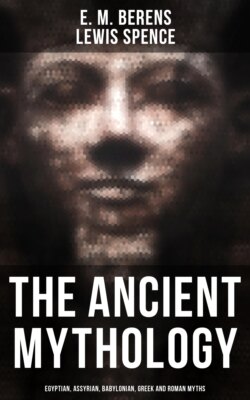Читать книгу The Ancient Mythology: Egyptian, Assyrian, Babylonian, Greek and Roman Myths - Lewis Spence - Страница 58
На сайте Литреса книга снята с продажи.
Anu
ОглавлениеAlong with En-lil and Ea, Anu makes up the universal triad. He is called the 'father of the gods,' but appears to be descended from still older deities. His name is seldom discovered in the inscriptions prior to the time of Khammurabi, but such notices as occur of him seem to have already fixed his position as a ruler of the sky. His cult was specially associated with the city of Erech. It is probable that in the earliest days he had been the original Sumerian sky-father, as his name is merely a form of the Sumerian word for 'heaven.' This idea is assisted by the manner in which his name is originally written in the inscriptions, as the symbol signifying it is usually that employed for 'heaven.' It is plain, therefore, that Anu was once regarded as the expanse of heaven itself, just as are the 'sky-fathers' of numerous primitive peoples. Several writers who deal with Anu appear to be of the opinion that a god of the heavens is an 'abstraction.' "Popular fancy," says Jastrow, "deals with realities and with personified powers whose workings are seen and felt. It would as little, therefore, have evolved the idea that there was a power to be identified with the heavens as a whole, of which the azure sky is a symbol, as it would personify the earth as a whole, or the bodies of waters as a whole. It is only necessary to state the implications involved to recognize that the conception of a triad of gods corresponding to three theoretical divisions of the universe is a bit of learned speculation. It smacks of the school. The conception of a god of heaven fits in moreover with the comparatively advanced period when the seats of the gods were placed in the skies and the gods identified with the stars."6 A merely superficial acquaintance with the nature of animism and the sky-myths of primitive and barbarian peoples would lead us to the conclusion that the opposite is the case. In Egyptian, Polynesian, and North American Indian myth the sky itself is directly personalized. Egyptian mythological illustration depicts the sky in female form, for in Egyptian myth the sky is the mother and the earth the father of everything. Lang has shown that the sky-father is frequently personalized as a "magnified non-natural man" among races which possess no theological schools. We do not say that the arrangement of Anu, Ea, and En-lil into a triad is not "a bit of learned speculation," but to state that early animism did not first personalize the sky and the earth and the sea is rash in the extreme. When Deucalion and Pyrrha in the Greek myth asked the gods how they might best replenish the earth with the human race, they were instructed to cast "the bones of their mother" behind them, and these bones they interpreted as the stones and rocks and acted accordingly. So would primitive man all the world over have interpreted this advice, for universally he believes the very soil upon which he walks to be the great mother which produced his ancestors, out of whose dust or clay they were formed, and who still nourishes and preserves him.
Jastrow proceeds to state that "Anu was originally the personification of some definite power of nature, and everything points to this power having been the sun in the heavens. Starting from this point of view we quite understand how the great illuminer of heaven should have been identified with the heavens in an artificially devised theological system, just as En-lil became in this system the designation of the earth and of the region above the earth viewed as a whole."7 The very fact that in the earliest times Anu was identified with the expanse of the sky itself, and that the symbol used to denote him meant 'heaven,' is against this supposition. Again, the theory suffers from lack of analogy. In what other mythology is there to be found a sky-god who at one time possessed a solar significance? The converse might be the case. Some sky-gods have attained the solar connexion because of their rule over the entire expanse of the heavens, just as they have attained the power of wielding lightning and the wind. But we are at a loss to recall any deity originally of distinctive solar attributes who later took the position of a sky-god.
Anu was regarded as head of the triad and the father of En-lil. We are told that the goddess Aruru first shaped man in the image of Anu, who must thus have attained an anthropomorphic condition. He appears also to have been regarded as the conqueror of primeval chaos. His consort was Anatu, probably a later feminine form of himself.
